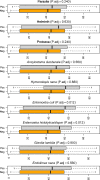Intestinal protozoan infections shape fecal bacterial microbiota in children from Guinea-Bissau
- PMID: 33657123
- PMCID: PMC7959362
- DOI: 10.1371/journal.pntd.0009232
Intestinal protozoan infections shape fecal bacterial microbiota in children from Guinea-Bissau
Abstract
Intestinal parasitic infections, caused by helminths and protozoa, are globally distributed and major causes of worldwide morbidity. The gut microbiota may modulate parasite virulence and host response upon infection. The complex interplay between parasites and the gut microbiota is poorly understood, partly due to sampling difficulties in remote areas with high parasite burden. In a large study of children in Guinea-Bissau, we found high prevalence of intestinal parasites. By sequencing of the 16S rRNA genes of fecal samples stored on filter paper from a total of 1,204 children, we demonstrate that the bacterial microbiota is not significantly altered by helminth infections, whereas it is shaped by the presence of both pathogenic and nonpathogenic protozoa, including Entamoeba (E.) spp. and Giardia (G.) lamblia. Within-sample diversity remains largely unaffected, whereas overall community composition is significantly affected by infection with both nonpathogenic E. coli (R2 = 0.0131, P = 0.0001) and Endolimax nana (R2 = 0.00902, P = 0.0001), and by pathogenic E. histolytica (R2 = 0.0164, P = 0.0001) and G. lamblia (R2 = 0.00676, P = 0.0001). Infections with multiple parasite species induces more pronounced shifts in microbiota community than mild ones. A total of 31 bacterial genera across all four major bacterial phyla were differentially abundant in protozoan infection as compared to noninfected individuals, including increased abundance of Prevotella, Campylobacter and two Clostridium clades, and decreased abundance of Collinsella, Lactobacillus, Ruminococcus, Veillonella and one Clostridium clade. In the present study, we demonstrate that the fecal bacterial microbiota is shaped by intestinal parasitic infection, with most pronounced associations for protozoan species. Our results provide insights into the interplay between the microbiota and intestinal parasites, which are valuable to understand infection biology and design further studies aimed at optimizing treatment strategies.
Conflict of interest statement
The authors have declared that no competing interests exist.
Figures




Similar articles
-
Study on intestinal parasitic infections and gut microbiota in cancer patients at a tertiary teaching hospital in Malaysia.Sci Rep. 2024 Jun 13;14(1):13650. doi: 10.1038/s41598-024-59969-6. Sci Rep. 2024. PMID: 38871760 Free PMC article.
-
Exposure to Parasitic Protists and Helminths Changes the Intestinal Community Structure of Bacterial Communities in a Cohort of Mother-Child Binomials from a Semirural Setting in Mexico.mSphere. 2021 Aug 25;6(4):e0008321. doi: 10.1128/mSphere.00083-21. Epub 2021 Aug 18. mSphere. 2021. PMID: 34406855 Free PMC article.
-
Impact of intestinal parasites on microbiota and cobalamin gene sequences: a pilot study.Parasit Vectors. 2020 Apr 19;13(1):200. doi: 10.1186/s13071-020-04073-7. Parasit Vectors. 2020. PMID: 32306993 Free PMC article.
-
Human Intestinal Microbiota: Interaction Between Parasites and the Host Immune Response.Arch Med Res. 2017 Nov;48(8):690-700. doi: 10.1016/j.arcmed.2017.11.015. Epub 2017 Dec 28. Arch Med Res. 2017. PMID: 29290328 Review.
-
Evaluating measures to control intestinal parasitic infections.World Health Stat Q. 1992;45(2-3):168-79. World Health Stat Q. 1992. PMID: 1462652 Review.
Cited by
-
Current Understanding of Giardia lamblia and Pathogenesis of Stunting and Cognitive Deficits in Children from Low- and Middle-Income Countries.Curr Trop Med Rep. 2024 Mar;11(1):28-39. doi: 10.1007/s40475-024-00314-2. Epub 2024 Jan 23. Curr Trop Med Rep. 2024. PMID: 38993355 Free PMC article.
-
Sickle Cell Disease and Gut Health: The Influence of Intestinal Parasites and the Microbiome on Angolan Children.Int J Mol Sci. 2024 Jul 1;25(13):7258. doi: 10.3390/ijms25137258. Int J Mol Sci. 2024. PMID: 39000364 Free PMC article.
-
Study on intestinal parasitic infections and gut microbiota in cancer patients at a tertiary teaching hospital in Malaysia.Sci Rep. 2024 Jun 13;14(1):13650. doi: 10.1038/s41598-024-59969-6. Sci Rep. 2024. PMID: 38871760 Free PMC article.
-
Detangling the Crosstalk Between Ascaris, Trichuris and Gut Microbiota: What´s Next?Front Cell Infect Microbiol. 2022 May 25;12:852900. doi: 10.3389/fcimb.2022.852900. eCollection 2022. Front Cell Infect Microbiol. 2022. PMID: 35694539 Free PMC article. Review.
-
Fecal microbiota transplantation from protozoa-exposed donors downregulates immune response in a germ-free mouse model, its role in immune response and physiology of the intestine.PLoS One. 2024 Oct 28;19(10):e0312775. doi: 10.1371/journal.pone.0312775. eCollection 2024. PLoS One. 2024. PMID: 39466773 Free PMC article.
References
-
- Kelly P. Intestinal protozoa. In: Farrar J, editor. Manson’s Tropical Infectious Diseases. 23rd ed. Elsevier; 2014. pp. 664–682.
Publication types
MeSH terms
Substances
LinkOut - more resources
Full Text Sources
Other Literature Sources
Miscellaneous

